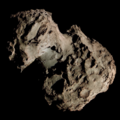 | |
| Discovery [2] | |
|---|---|
| Discovered by | James E. Gunn |
| Discovery site | Palomar Observatory |
| Discovery date | 17 October 1970 |
| Designations | |
| P/1954 P1, P/1970 U2 | |
| |
| Orbital characteristics [3] [4] | |
| Epoch | 17 October 2024 (JD 2460600.5) |
| Observation arc | 71.13 years |
| Earliest precovery date | 8 August 1954 [5] |
| Number of observations | 7,963 |
| Aphelion | 4.737 AU |
| Perihelion | 1.597 AU |
| Semi-major axis | 3.453 AU |
| Eccentricity | 0.3194 |
| Orbital period | 6.414 years |
| Inclination | 3.237° |
| 136.09° | |
| Argument of periapsis | 41.568° |
| Mean anomaly | 103.17° |
| Last perihelion | 16 June 2025 |
| Next perihelion | 11 February 2033 [6] |
| TJupiter | 2.991 |
| Earth MOID | 1.903 AU |
| Jupiter MOID | 0.396 AU |
| Physical characteristics | |
Mean radius | < 5.4 km (3.4 mi) [7] |
| (V–R) = 0.54±0.06 [8] | |
| Comet total magnitude (M1) | 10.1 |
65P/Gunn is a periodic comet in the Solar System orbiting the Sun every 6.41 years inside the main asteroid belt between the orbits of the planets Mars and Jupiter. [1]

